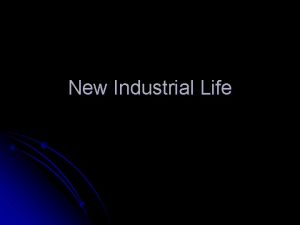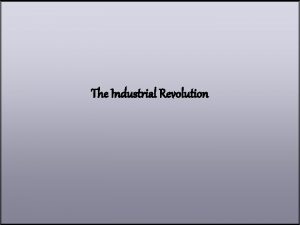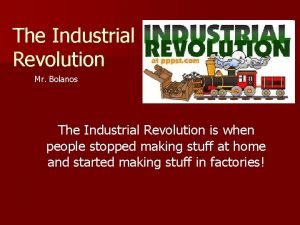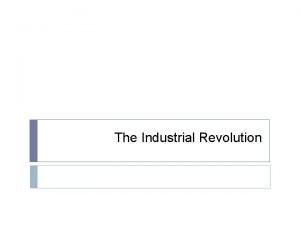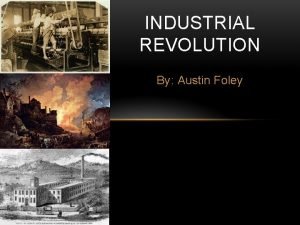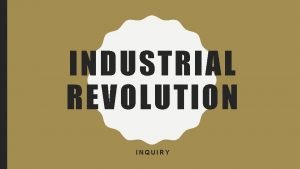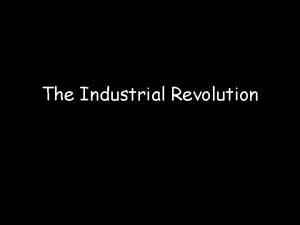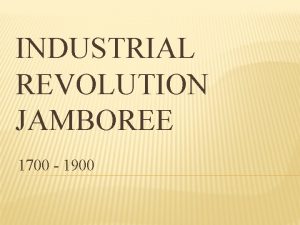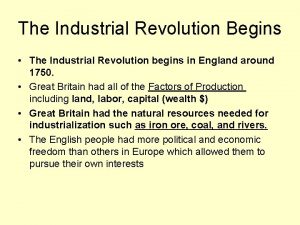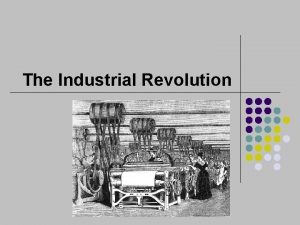The Industrial Revolution Industrial Revolution The Industrial Revolution









































- Slides: 41

The Industrial Revolution

Industrial Revolution The Industrial Revolution is when people stopped making stuff at home and started making stuff in factories.

Cottage Industry

Factory system

Cotton gin • His cotton gin removed the seeds out of raw cotton.



Steam Engine • The steam engine was not just a transportation device. It ran entire factories the way rivers used to.

Steam engine

Railroads


Early Canals

Panama Canal


Telegraph • Samuel Morse invented the telegraph. It communicated using a series of beeps (Morse code).

Immigration


Pull factors • Immigrants come to the USA and Canada for jobs and opportunities.

• Pull factors are good stuff to bring immigrants here like jobs.

• Jobs pulled immigrants here.

Push factors • Push factors are bad stuff to push immigrants away like war or disease or the potato famine.

• Many immigrants lived in tenements.

Tenement or Slum

Child labor • Many immigrants put their children to work ASAP.

Child labor • Shoeshine boys

Child labor • Bowling pin boys

Child labor • Coal miner boys

Child labor • Young miner

• Girls were preferred over boys in the textile industry. They were paid less, and had smaller hands to work with the treads.

Labor Reform • Labor unions struggled in the 1800 s to fight for better working conditions (shorter work day, workers’ comp).

Labor reform • Unions went on strike, and they often turned violent.

Unions are still very active

• The Factory Acts were laws that prohibited child labor.

• The also limited the number of hours that you worked

• The Factory Acts also required workplace safety.

These are young men who worked in textile factories. They have been maimed/crippled either by the machines or from years of labour that broke down their limbs.

Industrial efficiency • Henry Ford learned that the less people had to move, the faster they would work.

Ford’s assembly line

• The first cars were very expensive.

Model T • The Model T was the first car that middle class people could afford.

Model T • The assembly line lowered the cost of the Model T from $825 to $300.
 Russian revolution vs french revolution
Russian revolution vs french revolution You should hope that this game will be over soon
You should hope that this game will be over soon Definition of third agricultural revolution
Definition of third agricultural revolution Hệ hô hấp
Hệ hô hấp Các số nguyên tố
Các số nguyên tố Công của trọng lực
Công của trọng lực đặc điểm cơ thể của người tối cổ
đặc điểm cơ thể của người tối cổ Tỉ lệ cơ thể trẻ em
Tỉ lệ cơ thể trẻ em Các châu lục và đại dương trên thế giới
Các châu lục và đại dương trên thế giới ưu thế lai là gì
ưu thế lai là gì Thẻ vin
Thẻ vin Kể tên các môn thể thao
Kể tên các môn thể thao Tư thế ngồi viết
Tư thế ngồi viết Cái miệng nó xinh thế chỉ nói điều hay thôi
Cái miệng nó xinh thế chỉ nói điều hay thôi Hình ảnh bộ gõ cơ thể búng tay
Hình ảnh bộ gõ cơ thể búng tay Mật thư tọa độ 5x5
Mật thư tọa độ 5x5 Từ ngữ thể hiện lòng nhân hậu
Từ ngữ thể hiện lòng nhân hậu Trời xanh đây là của chúng ta thể thơ
Trời xanh đây là của chúng ta thể thơ Tư thế ngồi viết
Tư thế ngồi viết Voi kéo gỗ như thế nào
Voi kéo gỗ như thế nào Ví dụ giọng cùng tên
Ví dụ giọng cùng tên Thể thơ truyền thống
Thể thơ truyền thống Sự nuôi và dạy con của hổ
Sự nuôi và dạy con của hổ Thế nào là hệ số cao nhất
Thế nào là hệ số cao nhất Diễn thế sinh thái là
Diễn thế sinh thái là Vẽ hình chiếu vuông góc của vật thể sau
Vẽ hình chiếu vuông góc của vật thể sau Slidetodoc
Slidetodoc Phép trừ bù
Phép trừ bù Thế nào là mạng điện lắp đặt kiểu nổi
Thế nào là mạng điện lắp đặt kiểu nổi Lời thề hippocrates
Lời thề hippocrates Tư thế worms-breton
Tư thế worms-breton đại từ thay thế
đại từ thay thế Vẽ hình chiếu đứng bằng cạnh của vật thể
Vẽ hình chiếu đứng bằng cạnh của vật thể Quá trình desamine hóa có thể tạo ra
Quá trình desamine hóa có thể tạo ra Khi nào hổ mẹ dạy hổ con săn mồi
Khi nào hổ mẹ dạy hổ con săn mồi Các châu lục và đại dương trên thế giới
Các châu lục và đại dương trên thế giới Các loại đột biến cấu trúc nhiễm sắc thể
Các loại đột biến cấu trúc nhiễm sắc thể Thế nào là sự mỏi cơ
Thế nào là sự mỏi cơ Bổ thể
Bổ thể Phản ứng thế ankan
Phản ứng thế ankan Thiếu nhi thế giới liên hoan
Thiếu nhi thế giới liên hoan Fecboak
Fecboak












































